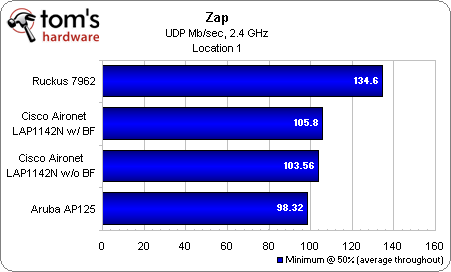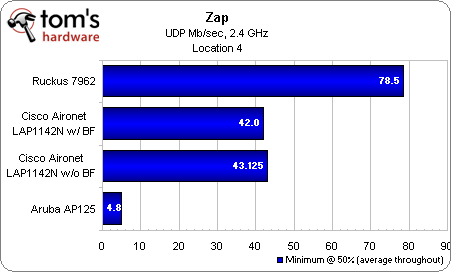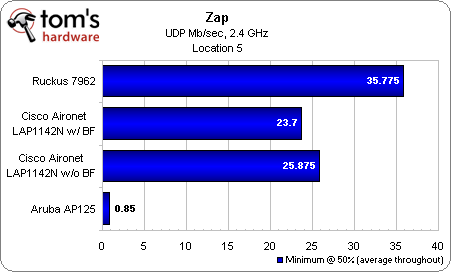Beamforming: The Best WiFi You’ve Never Seen
Zap In 2.4 GHz, Average
All right, let’s get down to business. In location 1, with the client and APs practically kissing, we see very solid numbers across the board in our Zap 50% tests. I was actually a little surprised to see Ruckus pull so far ahead in location 1 because beamforming shouldn’t provide much benefit at very close distances. We see this evident in the twin Cisco scores, which show beamforming only giving a 2 Mbps boost.
Our next two distance tests fall near expectations. I’m not surprised that Ruckus won these tests, but I am surprised that Aruba lagged so far behind Cisco, even without beamforming enabled. Speaking of which, location 3 shows Cisco’s beamforming advantage, but it’s interesting that location 2 does not, perhaps indicating that the arrangement was closer to line-of-sight than I might have imagined.
Secluded off in that meeting room at location 4, Aruba drops off a cliff, failing to average even 5 Mbps. And again, if anything, Cisco’s beamforming appears to impair performance slightly. Very odd.
In location 5, it’s more of the same, although Ruckus finally shows some signs of weakening. Aruba can barely hold a connection at less than 1 Mbps, but Cisco does relatively well—especially with beamforming disabled.
Obviously, the throughput number you expect for bare-minimum acceptable performance will vary based on application. If you want to hold two HD streams, then you need at least 40 Mbps and preferably more for possible sporadic interference. At 2.4 GHz, none of these access points could handle this, but who would really set up a scenario like this in real life? As we continue, keep in mind that these tests are meant to prove or disprove the viability of WiFi beamforming, not necessarily to show how equipment should perform in a given situation.
Get Tom's Hardware's best news and in-depth reviews, straight to your inbox.
Current page: Zap In 2.4 GHz, Average
Prev Page Test Apps And Methods Next Page Zap In 5 GHz, Average-
pirateboy just what we need, more retarded failnoobs clogging up the airwaves with useless braindead movieclips...yaayReply -
bucifer This article started up pretty good with lots of technical data and the beamforming technology in theory but after that the goodness stopped.Reply
1.You cannot compare two products by testing them with a in-house developed software. It's like testing ATI vs nVIDIA with nvidia made benchmark.
2.If you do something get it done, don't just go with half measures. I don't care if you didn't have time. You should have planned this from the beginning. The tests are incomplete, and the article is filled with crap of Rukus and Cisco. -
Mr_Man In defense of your wife, you didn't HAVE to use that particular channel to view all the "detail".Reply -
@Mr_Man: With a name like yours, I'd think that you'd sympathize with Chris a bit more :P Unless (Mr_Man == I likes men) :DReply
-
Pei-chen Both Tyra and Heidi have personal issues and would be pretty difficult friend/mate.Reply
The network idea sounds better. I couldn’t get my 10 feet g network to transmit a tenth as much as my wired network without it dropping.
-
zak_mckraken There's one question that I think was not covered by the article. Can a beamformaing AP can sustain the above numbers on two different clients? Let's say we take the UDP test at 5 GHz. The result shows 7.3 Mb/s. If we had two clients at opposite sides of the AP doing the same test, would we have 7.3 Mb/s for each test or would the bandwidth be sliced in 2?Reply
The numbers so far are astonishing, but are they realistic in a multi-client environnement? That's something I'd like to know!




